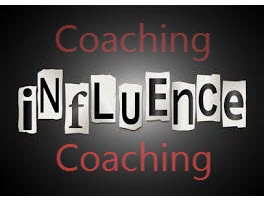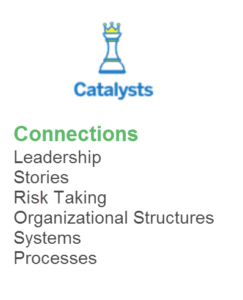 How do we coach leaders and executives within the context of the Complexity Space™ Framework (CSF)? We help them build their skill at influencing change.
How do we coach leaders and executives within the context of the Complexity Space™ Framework (CSF)? We help them build their skill at influencing change.
We first need to explain our definition of Leadership as, “practiced formal and informal roles within an organization’s Ecosystem for accountability, authority, decision making, risk taking and innovation.” On the surface this may not seem too far from more traditional takes on leadership but it is how a leader works in the CSF that is different.
In the Complexity Space™ Framework, continuous, often unpredictable change is the “normal” state. Traditional top-down, “command and control” styles of leadership are not effective when the “right” answer is always changing! It becomes even more critical to have leaders consciously act as catalysts that are both confident and conscious that perturbing existing patterns will influence the system to change.
Think “Influence-ship”
We call this skill “influence-ship” to distinguish it from traditional leadership approaches and further explain the differences that leaders confront in complex systems.
Coaching in the CSF focuses on developing the individual’s capacity to understand and influence other people by recognizing behaviors (patterns) within the context of the organization’s Ecosystem – history culture, context, and motivation. We believe it is possible to intentionally influence behaviors when there is an understanding of the system-wide patterns that got us to where we are now.
The one-day “Blitz”
A senior manager we had met during a reorganization project we were working with recently mentioned her frustration in identifying “What comes next?” in her career. Early on she decided to touch base with an internal coach and shared that the conversations kept going down the same path, resulting in her ending up in the same “stuck” place she had been before. We are assigning no blame for this result and the coach may have been equally frustrated with Sally!
We asked Sally (not her real name) if she would be interested in a different approach to the issue; an approach based the principles of complexity. She was willing to try something different and we arranged for a one-day “blitz” to see what we might discover.
The session began with a brief introduction to the properties of complex systems. Sally quickly grasped the distinction between complex systems as “machines” – linear, predictable, “do this and that will happen,” and systems as “gardens” – no guarantees, emerging; can be influenced but not controlled.
 We then shared the elements of the Complexity Space™ Framework and briefly described each with an understanding that we would start with the first appropriate step of the Navigation Process and see where we landed. In this case, the appropriate question we asked is, “Is where you are now where you want to be?” Sally determined that she would like to leave the session feeling reconnected to her search, inspired to think bigger and differently, and ideally to have some new ideas emerge for further consideration.
We then shared the elements of the Complexity Space™ Framework and briefly described each with an understanding that we would start with the first appropriate step of the Navigation Process and see where we landed. In this case, the appropriate question we asked is, “Is where you are now where you want to be?” Sally determined that she would like to leave the session feeling reconnected to her search, inspired to think bigger and differently, and ideally to have some new ideas emerge for further consideration.
Having determined she wanted new thinking, we recognized the value of stepping “backwards” to the patterns that contributed to her current decisions. We spent time assessing the Ecosystem Dimensions with a focus on her patterns for thinking about her career choices. We focused the conversations on each of the four Dimensions based on her desired outcomes for the day.
For example, our discussion of “History” centered around her various education and career choices and accomplishment. The “Motivation” conversation revolved around her goals and objectives. What did she want from her job in the short- and long-term? How have answers changed over time? We did the same for the “Context” – how had the surrounding environment changed. Finally, we explored the upcoming changes to perceived “Culture” in her current organization.
The focus for these conversations was learning and sharing rather than evaluating or fixing. We helped Sally when she fell into the typical trap of judging herself, reminding herself that the act of talking about these issues is what was most important.
After a break, we moved forward to identify the criteria that would be important for Sally to consider as she contemplated various possible short- and long-term moves. Those criteria included work-life balance, ability to retain a reasonable amount of freedom and control, a strong desire for periodic international travel, and the ability to bring as much of her education, skills, and experience as possible to her next career moves. Interestingly, money, benefits, promotion, and having a fancy title were not perceived to be nearly as important as the first items listed.
In an interesting (and non-traditional coaching) step, Sally asked us to brainstorm potential next steps. Her hope was that hearing suggestions from a different person(s) might add some new ideas, and allow her to “switch channels” from talking to herself and others to listening.
 We responded in a non-traditional way, challenging her to think about what new patterns of thought and action might result in different ways for her to achieve her goals. Given our limited time, we suggested focusing on one of the seven CSF Catalysts to provide an example of how she could think differently. We chose to explore “Connections.” Challenging her to look beyond her “usual” networks, we asked her to connect with two people – one inside and one outside her current organization – whom she would not normally discuss career guidance.
We responded in a non-traditional way, challenging her to think about what new patterns of thought and action might result in different ways for her to achieve her goals. Given our limited time, we suggested focusing on one of the seven CSF Catalysts to provide an example of how she could think differently. We chose to explore “Connections.” Challenging her to look beyond her “usual” networks, we asked her to connect with two people – one inside and one outside her current organization – whom she would not normally discuss career guidance.
As the day ended, Sally committed to exploring the other Catalysts on her own and identifying potential actions she could take. We suggested she then prioritize those against her desired outcome and identify “the next smart steps” – and take them!
Taking those steps will disrupt her career patterns, triggering the learning cycles inherent in the Navigation Process. We agreed to continue the dialogue in the coming weeks.
What patterns might you challenge as you think about your career?
We hope you will share your stories, questions and even disagreements with our articles because that is the only way we can continue to make sure Complexity Works.
